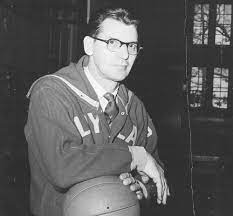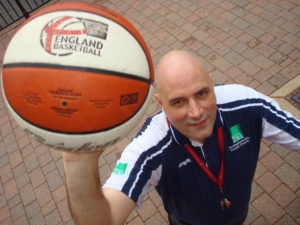There have been a lot of amazing athletes nicknamed “Lefty” including Hall of Fame pitcher Steve Carlton and 6-time major winner Phil Mickelson. It is also a popular nickname for basketball coaches such as Hall of Famer Lefty Driesell. One coach you may not have heard of before is Emil “Lefty” Reitz, who won almost 350 games as basketball coach at Loyola MD. In his spare time he also won 290 games as coach of the baseball team, coached lacrosse/cross country/soccer, and had Reitz Arena named in his honor. He passed away in 1992 but HoopsHD’s Jon Teitel got to chat with Lefty’s biographer Jimmy Smith about Lefty’s coaching career. Today is the 112th anniversary of Lefty’s birth on January 18, 1910 so we take this time to honor his life/legacy.
Reitz went to Villanova before playing 3 years of pro baseball: how good of an athlete was he back in the day? In order to understand who Lefty Reitz was it is important to understand the times in which he lived. At the beginning these were “hard times”. Throughout those years of economic austerity Americans lived by and cherished a set of values that for many were non-negotiable. These values centered on belief in God, family, and education. Lefty was devoted to his parents. His father (Emil “Pop” Reitz Sr.) was a former minor league baseball pitcher and well known in Baltimore as a manager/coach for various company teams and clubs until his death in 1943. Lefty grew up playing every sport in season: baseball, football and “basket-ball”. Baseball was the sport he enjoyed the most and excelled in. As an example, while a sophomore at Loyola High School, Lefty struck out 12 Calvert Hall batters in a 7-inning game…and the next year he was playing for Calvert Hall. (See Running With The Greyhounds, Chapter 2: Lefty Reitz, An Honorable Life). But yes, he was good enough to be All-Maryland Scholastic Association in both baseball/basketball while at Calvert Hall. He actually played on five Maryland Scholastic Association championship teams: in basketball at Loyola High School in 1927 and in baseball/basketball at Calvert Hall, coached by another Maryland legend, Valentine “Dutch” Lentz, during the following two years.
He later became coach at Loyola MD: how did he get into coaching? Emil “Lefty” Reitz’s life (1910-1992) paralleled the growth and popularity of sports in America, in particular “college sports”. Loyola University Maryland’s Jesuits hired him toward the end of the Great Depression in 1937. During Lefty’s lifetime, coaches/athletic directors were held in high esteem in their communities. Mr. Reitz’s biography, Running With The Greyhounds, A Century of Loyola Maryland Basketball History (http://runningwiththegreyhounds.webs.com), is an example of just how prestigious it was to be a sports coach in 20th century America. The Jesuits were running Loyola College of Baltimore (as it was then known) with the aid of very few laymen or non-Jesuits. Dr. Ed Doehler (Class of 1930) taught in the history department as 1 of perhaps 2-3 laymen. The Jesuit teachers/administrators of Loyola were unsalaried and only hired lay employees with skill sets they did not have among themselves or did not have time to do: enter Lefty. He was as well known in 1930’s Baltimore sporting circles as any professional athlete is today, but without the “celebrity”. Fr. John Jacobs, SJ, Loyola’s Treasurer and Moderator of Athletics either knew Lefty personally or at least knew who he was. Mr. Reitz entered Loyola’s employment at a time of disharmony between the alumni, faculty, and students. Loyola’s sports-minded alumni were still reeling from the administration’s decision to “drop” football as their main sport in 1934. It was now 1937 and having just lost very popular alumnus Bill Liston as their basketball coach/athletic director, Loyola’s Jesuits needed an extraordinary replacement who could not only coach but could help lift the school’s spirit in spite of not having a football team. In addition, they would have only hired a man of Christian character to whom they could entrust their students. Throw in the fact that Lefty owned a car and in Father “Jake’s” eyes he was the ideal person for the job. Initially, Lefty was hired to coach the basketball team in 1937. He inherited a program which had won only 3 games the season before but turned the Greyhounds around in his first season with a modest 9-7 record. Loyola Baltimore was no launching pad for future job prospects back then (as it has been considered in recent times) so Mr. Reitz was there to stay. In terms of coaching and athletic administration at one school: 36 years, touching 5 different decades in the 20th century, was an extraordinary length of service (1937-1973). You have heard the saying, “Winning is a habit,” Well, you could certainly say that about Lefty. Everywhere he went his teams won. Lefty began getting coaching experience with his dad’s younger teams in sandlot baseball in the 1920’s. His formal coaching career began at Villanova when he suffered a career-ending shoulder injury as a sophomore on the football team in 1930. His scholarship was dependent on him playing 3 sports, so Villanova’s athletic director came up with a solution. Harry Stuhldreher, Villanova AD/head football coach, put Reitz in charge of Nova’s’ 150-pound football team. Stuhldreher, one of Notre Dame’s “Four Horsemen” under legendary coach Knute Rockne, turned that tragic situation into a blessing. The shoulder injury also impacted Lefty’s pro baseball career. He was a dominant pitcher/ first baseman at the college level but found it increasingly difficult to perform at the pro level on a consistent basis.
He had an interesting philosophy on recruiting which resulted in prospective players having to contact Loyola on their own: why did he choose that method, and how effective was it? Regarding Lefty’s philosophy of recruiting, you have to understand who he was. Put simply, if you measure him on performance then he was the best coach in Maryland…but he had to prioritize what he did with his time. He was delivering an entire college sports program and coaching multiple sports, so if he wanted scholarships then he would have to fundraise himself. That was his job, but he also had a family that he loved to spend time with. Over and above that, he did not want any student-athlete, not even the great Jim Lacy Jr. (See Running With The Greyhounds, Chapter 4), to think they were doing Loyola a favor. Lefty had to know that a prospect really wanted to attend Loyola and (if they were good enough) play for him. During Lefty’s last 4 seasons as basketball coach (1957-1961) Loyola employed his first assistant coach, a former star player named Edward “Nap” Doherty, who succeeded him as head coach. Nap recruited for Lefty’s teams but could only recruit locally and as far afield as he had family because there was no budget for recruiting. Ironically, during that first active recruiting period, Loyola did not win a single championship.
He led his teams to several NAIA and National Catholic Intercollegiate Tourneys: what is your favorite postseason memory? My favorite postseason memory is in Jim Lacy Jr.’s senior year, 1948-49. Jim was headed for a national scoring record while playing on Loyola’s greatest team (25-8). Vince Bagli (Class of 1949) sat at Lefty’s desk in the gym at Loyola for 6 postseason games, broadcasting from a Western Union wire hook-up in Kansas City/Denver to the students down the hallway in the “Rec Room”. Vince, who passed away in 2020 at age 93, was known as “The Dean” of Baltimore sportscasters. This opportunity propelled Vince into a 46-year sports broadcasting career (including 31 years on WBAL-TV). It was through Vince that Loyola fans first learned that Lacy had set a new national scoring record with 2199 career PTS (See Running with the Greyhounds, Chapters 5 and 9).
He remains the winningest coach in school history: what made him such a great coach, and do you think that anyone will ever break his record? As far as his career coaching record in basketball (349-228), it is highly unlikely but not impossible that we will ever see anyone win more basketball games at Loyola Maryland. It could be done…if a coach stayed for 24 seasons and averaged 15 wins/season. Lefty’s legacy is really about the kind of person he was: a great leader, molder of men, knowledgeable, an excellent teacher, and as a role model he had few peers. He was the perfect extension in the sporting realm of the Jesuit Fathers: strict but fair and greatly respected by the students, as well as the student-athletes/faculty/alumni of Loyola.
He also served as baseball and soccer coach/AD/conference commissioner: how did he like the other gigs compared to being a basketball coach? From 1939-1956, Loyola won 12 basketball championships. Lefty retired as basketball coach in 1961 because he felt Nap Doherty (Class of 1953) was ready to step up as head coach. In the modern era, coaching two/three sports and being athletic director would be considered “too much”. However, if he had not thought that Nap was ready then he would not have stepped down when he did. About the same time, Loyola’s soccer program was handed over to Jim Bullington (Class of 1952), which resulted in Loyola Men’s Soccer winning the school’s 1st NCAA title in 1976. Lefty always surrounded himself with great people who were not just coaches but cared about the student-athletes as much as he did.
The school later named its basketball arena after him: what did it mean to him to receive such an outstanding honor? Perhaps the ultimate accolade to Lefty was the naming of “Reitz Arena” in his honor in 1983.The capital fundraising campaign was led by none other than ABC Wide World of Sports anchorman Jim McKay (Class of 1943). Mr. McKay, known as Jim McManus while a Loyola student (1939-43), accepted the leadership of the campaign with the understanding that the arena would be named in Lefty’s honor. It meant the world to Lefty’s family to have the arena named after him. Lefty’s “boys” response to the campaign was overwhelming and they surpassed the target amount. Lefty was blessed/impressed by the number of donors and by the fact that there were many 1st-time donations to Loyola. Mr. Reitz was unable to attend the opening of “Reitz Arena” due to a stroke but recovered and attended many games with his wife Marge sitting behind the scorer’s table.
When people look back on his career, how do you think that he should be remembered the most? One nice memory the Reitz family has is that during one losing streak Lefty was asked to inspire the Greyhounds in a pre-game pep talk…and they won. Lefty Reitz built and established Loyola Maryland’s athletic program in which generations of Greyhounds have enjoyed and thrived, while playing a leading role in the development of college sports in the Mid-Atlantic Region. He participated in the desegregation of college basketball in the South and facilitated the integration of Loyola’s athletic program without any fanfare. As an extension of Jesuit education and ideals, Lefty was a wonderful friend to all, a loving family man, and a great ambassador for Loyola. Jim Henneman, a former News American reporter who later spent more than 2 decades as official scorekeeper for the Baltimore Orioles, referred to Lefty as “Mr. Loyola”. That is how Emil G. “Lefty” Reitz Jr. should always be remembered: with gratitude, affection, and respect for what he achieved for Loyola.
Jimmy “Jumpshot” Smith, a 1976 alumnus of Loyola Maryland, is the author of Running with the Greyhounds, A Century of Loyola Maryland Basketball History (foreword by Morgan Wootten, Naismith Basketball Hall of Fame Class of 2000). For more information go to: http://runningwiththegreyhounds.webs.com
or www.facebook.com/runningwiththegreyhounds or contact the author at: jimmy-jumpshot@hotmail.com




